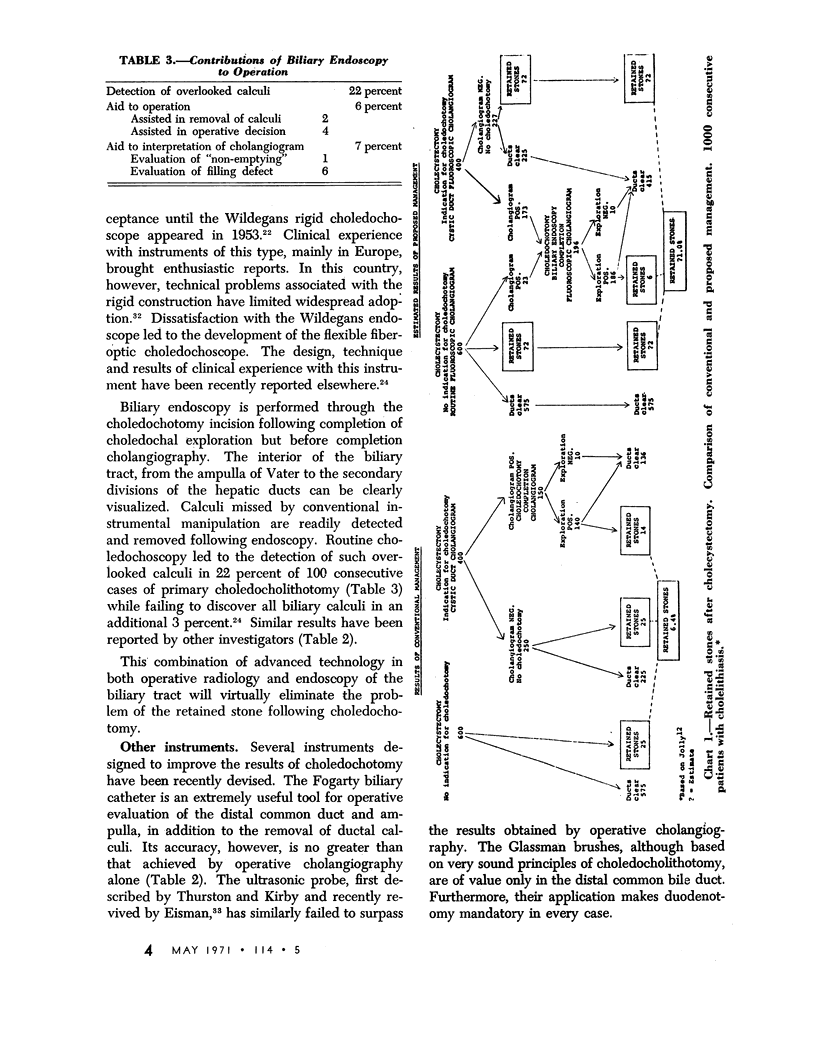Abstract
Residual calculi following cholecystectomy may be expected in approximately seven percent of cases. The vast majority of these are overlooked during operation; truly re-formed stones are rare.
Calculi are missed during cholecystectomy because of failure to explore the common bile duct. This is due to (1) the presence of silent choledochal stones, and (2) reliance on negative cystic duct cholangiograms in the presence of indications for common duct exploration.
Overlooking of silent stones during cholecystectomy may be prevented by routine operative cholangiography. Ideally, false-negative cystic duct cholangiograms should be eliminated by the use of fluoroscopic cholangiography.
Retained calculi following duct exploration may be prevented by (a) routine biliary endoscopy and (b) completion fluoroscopic cholangiography.
Re-formation of ductal calculi can probably be prevented by appropriate biliary drainage procedures performed during the initial choledochotomy. Selection of patients for primary biliary decompression remains an experimental problem.
Full text
PDF





Selected References
These references are in PubMed. This may not be the complete list of references from this article.
- Acosta J. M., Fotheringham W. T., Ruiz L. O., Nardi G. L. Operative cholangiography. Arch Surg. 1969 Jul;99(1):29–32. doi: 10.1001/archsurg.1969.01340130031006. [DOI] [PubMed] [Google Scholar]
- Allen K. L. Routine operative cholangiography. Am J Surg. 1969 Oct;118(4):573–576. doi: 10.1016/0002-9610(69)90187-1. [DOI] [PubMed] [Google Scholar]
- BERCI G., JOHNSON N. FUNCTIONAL STUDIES OF THE EXTRAHEPATIC BILIARY SYSTEM IN THE DOG BY USE OF A CONTROLLED BILIARY FISTULA. Ann Surg. 1965 Feb;161:286–292. doi: 10.1097/00000658-196502000-00018. [DOI] [PMC free article] [PubMed] [Google Scholar]
- Bodvall B., Overgaard B. Computer analysis of postcholecystectomy biliary tract symptoms. Surg Gynecol Obstet. 1967 Apr;124(4):723–732. [PubMed] [Google Scholar]
- CHAPMAN M., CURRY R. C., LEQUESNE L. P. OPERATIVE CHOLANGIOGRAPHY. AN ASSESSMENT OF ITS RELIABILITY IN THE DIAGNOSIS OF A NORMAL, STONE-FREE COMMON BILE-DUCT. Br J Surg. 1964 Aug;51:600–601. doi: 10.1002/bjs.1800510812. [DOI] [PubMed] [Google Scholar]
- COLCOCK B. P., LIDDLE H. V. Commonbile-duct stones. N Engl J Med. 1958 Feb 6;258(6):264–268. doi: 10.1056/NEJM195802062580602. [DOI] [PubMed] [Google Scholar]
- FERRIS D. O., WEBER H. M. Evaluation of routine operative cholangiography. AMA Arch Surg. 1956 Aug;73(2):197–203. doi: 10.1001/archsurg.1956.01280020011003. [DOI] [PubMed] [Google Scholar]
- Griffin T. F., Wild A. A. The case for peroperative cholangiography. Br J Surg. 1967 Jul;54(7):609–615. doi: 10.1002/bjs.1800540710. [DOI] [PubMed] [Google Scholar]
- HICKEN N. F., MCALLISTER A. J. OPERATIVE CHOLANGIOGRAPHY AS AN AID IN REDUCING THE INCIDENCE OF "OVERLOOKED" COMMON BILE DUCT STONES: A STUDY OF 1,293 CHOLEDOCHOLITHOTOMIES. Surgery. 1964 Jun;55:753–758. [PubMed] [Google Scholar]
- HIGHT D., LINGLEY J. R., HURTUBISE F. An evaluation of operative cholangiograms as a guide to common duct exploration. Ann Surg. 1959 Dec;150:1086–1091. doi: 10.1097/00000658-195912000-00017. [DOI] [PMC free article] [PubMed] [Google Scholar]
- HURWITZ A., DEGENSHEIN G. A. THE ROLE OF CHOLEDOCHODUODENOSTOMY IN COMMON DUCT SURGERY: REAPPRAISAL. Surgery. 1964 Dec;56:1147–1150. [PubMed] [Google Scholar]
- HUTCHINSON W. B., BLAKE T. Operative cholangiography. Surgery. 1957 Apr;41(4):605–612. [PubMed] [Google Scholar]
- ISAACS J. P., DAVES M. L. Technique and evaluation of operative cholangiography. Surg Gynecol Obstet. 1960 Jul;111:103–112. [PubMed] [Google Scholar]
- JACOBSSON B. Determination of pressure in the common bile duct at and after operation. Acta Chir Scand. 1957 Oct 12;113(6):483–488. [PubMed] [Google Scholar]
- JOHNSTON E. V., WAUGH J. M., GOOD C. A. Residual stones in the common bile duct: the question of operative cholangiograms. Ann Surg. 1954 Mar;139(3):293–301. doi: 10.1097/00000658-195403000-00006. [DOI] [PMC free article] [PubMed] [Google Scholar]
- Jolly P. C., Baker J. W., Schmidt H. M., Walker J. H., Holm J. C. Operative cholangiography: a case for its routine use. Ann Surg. 1968 Sep;168(3):551–565. doi: 10.1097/00000658-196809000-00019. [DOI] [PMC free article] [PubMed] [Google Scholar]
- Letton A. H., Wilson J. P. Routine cholangiography during biliary tract operations: technic and utility in 200 consecutive cases. Ann Surg. 1966 Jun;163(6):937–942. doi: 10.1097/00000658-196606000-00015. [DOI] [PMC free article] [PubMed] [Google Scholar]
- MADSEN C. M. Routine or elective cholangiography during cholecystectomy? Acta Chir Scand Suppl. 1961;Suppl 283:247–254. [PubMed] [Google Scholar]
- MALLET-GUY P. Television radioscopy during operations on the biliary passages. Surg Gynecol Obstet. 1958 Jun;106(6):747–748. [PubMed] [Google Scholar]
- MALLET-GUY P. Value of peroperative manometric and roentgenographic examination in the diagnosis of pathologic changes and functional disturbances of the biliary tract. Surg Gynecol Obstet. 1952 Apr;94(4):385–393. [PubMed] [Google Scholar]
- MEHN W. H. Operating room cholangiography. Surg Clin North Am. 1954 Feb;:151–158. doi: 10.1016/s0039-6109(16)34139-1. [DOI] [PubMed] [Google Scholar]
- PYRTEK L. J., BARTUS S. H. Critical evaluation of routine and selective operating room cholangiography. Am J Surg. 1962 Jun;103:761–768. doi: 10.1016/0002-9610(62)90263-5. [DOI] [PubMed] [Google Scholar]
- SHORE J. M., LIPPMAN H. N. Operative endoscopy of the biliary tract. Ann Surg. 1962 Dec;156:951–955. doi: 10.1097/00000658-196212000-00013. [DOI] [PMC free article] [PubMed] [Google Scholar]
- SMITH R. B., 3rd, CONKLIN E. F., PORTER M. R. A five year study of choledocholithiasis. Surg Gynecol Obstet. 1963 Jun;116:731–740. [PubMed] [Google Scholar]
- SMITH S. W., ENGEL C., AVERBOOK B., LONGMIRE W. P., Jr Problems of retained and recurrent common bile duct stones. J Am Med Assoc. 1957 May 18;164(3):231–236. doi: 10.1001/jama.1957.02980030007002. [DOI] [PubMed] [Google Scholar]
- SWEDBERG J. Routine cholangiography at operations for gall stones. Acta Chir Scand. 1952 Jun 10;103(3):175–193. [PubMed] [Google Scholar]
- Schein C. J., Beneventano T. C. Biliary manometry: its role in clinical surgery. Surgery. 1970 Feb;67(2):255–260. [PubMed] [Google Scholar]
- Schein C. J., Beneventano T. C., Rosen R. G., Dardik H. M., Gliedman M. L. Hepatic plexus vagectomy as an adjunct to cholecystectomy. Surg Gynecol Obstet. 1969 Feb;128(2):241–251. [PubMed] [Google Scholar]
- Schein C. J. Biliary endoscopy: an appraisal of its value in biliary lithiasis. Surgery. 1969 Jun;65(6):1004–1006. [PubMed] [Google Scholar]
- Schulenburg C. A. Operative cholangiography: 1,000 cases. Surgery. 1969 May;65(5):723–739. [PubMed] [Google Scholar]
- Shore J. M., Shore E. Operative biliary endoscopy: experience with the flexible choledochoscope in 100 consecutive choledocholithotomies. Ann Surg. 1970 Feb;171(2):269–278. doi: 10.1097/00000658-197002000-00016. [DOI] [PMC free article] [PubMed] [Google Scholar]
- Whitaker P. H., Parkinson E. G., Hughes J. H. Television fluoroscopy for operative cholangiography. An analysis of 150 cases. Clin Radiol. 1968 Oct;19(4):368–378. doi: 10.1016/s0009-9260(68)80076-5. [DOI] [PubMed] [Google Scholar]


